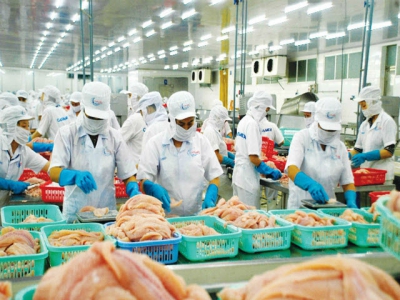After Covid-19 epidemic peak, Chinese market opens again to Vietnams catfish

Catfish exporters hope that orders from China will increase again as this country has passed the Covid-19 epidemic peak.
Navico’s managers believe that the company’s 100 percent self-supply of catfish materials is a great advantage that will allow it to increase catfish exports to China.
After Covid-19 epidemic peak, Chinese market opens again to Vietnam’s catfish
In 2019, China spent $728.6 million dollars to import catfish from Vietnam. In the same year, Navico exported 3,290 containers of products with revenue of $153.5 million, a 10-year high, an increase of 19 percent compared with 2018.
However, Navico’s exports to China dropped sharply by 87 percent last February, posing threats to the company’s goal for sustainable growth.
According to Doan Toi, Navico’s general director, the company keeps production, but at lower capacity. Catfish exports in the first two months of the year brought turnover of $2.03 billion, down by 10.2 percent compared with 2018.
China, together with Southeast Asia and Europe, are the three major export markets for Navico.
According to Doan Toi, Navico’s general director, the company keeps production, but at lower capacity. Catfish exports in the first two months of the year brought turnover of $2.03 billion, down by 10.2 percent compared with 2018.
The Chinese market consumes 36 percent of Vietnam’s catfish exports.
The Ministry of Agriculture and Rural Development (MARD) reported that Vietnam’s exports to China dropped by 52 percent in the first two months of 2020 because of the sluggish retail network and stuck delivery system in Covid-19.
As exports to China go down, Vinh Hoan JSC has lowered the business target by 10 percent, while increasing exports to the EU.
Vinh Hoan expects to see net revenue increasing by 10 percent this year, but the post-tax profit may decrease by 19 percent as predicted by BIDV Securities (BSC).
The selling price is predicted to decrease by 2 percent from 2019, while the input costs are predicted to increase by 9 percent.
According to Duong Nghia Quoc, chair of the Vietnam Pangasius Association, China has tightened requirements on food hygiene on imports and strengthened its own domestic catfish farming.
The Chinese Evergreen Group, which can process 7,000 tons of catfish products a year is a big rival which may cause Vietnam’s catfish market share in China to decrease.
Meanwhile, GSO’s (General Statistics Office) latest report showed that the catfish price is at a 10-year low.
The catfish output in March 2020 is estimated at 74,700 tons, down by 8.8 percent compared with the same period last year. The figure is 242,800 tons in Q1, down by 3.7 percent.
However, many businesses believe that the decline of the Chinese market is just temporary, and that more orders will come as the epidemic peak in the country is over.
Related news
 Farmers to move fish cages to prevent them from dying
Farmers to move fish cages to prevent them from dying A total of 168 households raising fish along the La Ngà River in Đồng Nai Province will move their cages to more suitable places to prevent the fish from dying
 Shrimp exports to China show drastic upturn after five years
Shrimp exports to China show drastic upturn after five years China has remained the main buyer of Vietnamese shrimp over the past 5 years, with an average annual growth of 16% and the figure rose to over 55%
 Đồng Tháp helps fish exporters amid lower demand during COVID-19
Đồng Tháp helps fish exporters amid lower demand during COVID-19 The province is also examining export activities to propose solutions to ministries and authorities about exporters' problems.